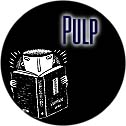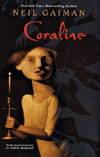
Comment
on this story
|
 |

Was that a ghost? Nope, just a turning page.
by Paul Lewis
Several years ago, prodded on by the huge sales of Stephen King and Dean Koontz, horror novels had a surge on our nation's bookshelves. While King and Koontz still have popular followings and bestselling titles, a lot of their progeny have been forced from the stacks by true crime books and their ilk, and today many of even the good horror writers make their living off specialty presses and the occasional anthology. Luckily, genuinely creepy books are still out there, some in very obvious dress, and others might sneak up on us if we're not too careful. And who doesn't enjoy a good scare every now and then?
A dust jacket featuring a large pentagram dripping blood announces to a potential reader that John Shirley's Demons (Del Rey, $25) might well be a book featuring horrific scenes and themes. In a case of truth in advertising, yes, that's exactly what Demons is—unapologetically, it's a horror novel. It's also much, much more, and will surely infuriate fans who only care to count the beheadings and measure the bloodlettings in gallons. Originally two novellas now collected into novel form, Demons chronicles a not-too-distant future when seven "clans" of demonic creatures suddenly and mysteriously appear throughout the world and systematically kill and destroy everything in their paths. a horror novel. It's also much, much more, and will surely infuriate fans who only care to count the beheadings and measure the bloodlettings in gallons. Originally two novellas now collected into novel form, Demons chronicles a not-too-distant future when seven "clans" of demonic creatures suddenly and mysteriously appear throughout the world and systematically kill and destroy everything in their paths.
Humanity tries to cope—some by continuing their everyday lives, as much as they can, while others embrace the demons as worshippers or fans (a website devoted to the clans is a nice touch). Below the awareness of the man on the street, a collection of academics, philosophers, and mystics prepares a counter-strike, because the sickening truth is that other human agents are responsible for the demonic presence.
Demons is bolstered by a definite agenda that never gets in the way of its storytelling. It's nothing less than a call for rationality, intelligence, and the better aspects of humanity to overcome the pollution, both literal and figurative, that we have unleashed upon ourselves. It's even a call to transcendence, to spirituality, but not in a "holy water defeats the vampire" kind of way.
Sure, it doesn't always move as briskly as it could, and in the end the demons themselves are used fairly sparingly, but like most good horror, sometimes the monsters are more effective when you hardly ever see them, skirting in shadows or the traps and snares of our imagination.
Neil Gaiman's Coraline (HarperCollins, $15.99) is the overtly tricky title—a genuinely chilling tale disguising itself as a modern children's fable. In true children's book fashion, it  even has atmospheric illustrations by Gaiman über-collaborator Dave McKean (cover artist for each and every one of Gaiman's Sandman comic books). But like the best children's books (Lloyd Alexander's Prydain Chronicles, for instance), and in a marketplace bolstered by the multi-generational acceptance of a certain boy wizard, Coraline is a story tykes and adults both can wrap their sensibilities around. even has atmospheric illustrations by Gaiman über-collaborator Dave McKean (cover artist for each and every one of Gaiman's Sandman comic books). But like the best children's books (Lloyd Alexander's Prydain Chronicles, for instance), and in a marketplace bolstered by the multi-generational acceptance of a certain boy wizard, Coraline is a story tykes and adults both can wrap their sensibilities around.
Coraline, the titular character, is a young girl with busy professional parents who have moved into a new flat with eccentric neighbors. An explorer by heart, Coraline sweeps the grounds day after day until she's discovered everything, including a door that goes nowhere in her family's storage room. After finding a key, she is able to open the door and enter a mirror-image world where her mother and father are attentive and fun—but there's the bizarre detail that her new parents have black buttons for eyes. With a decidedly particular cat as her only ally, she must escape this world and, yes, rescue her real parents while tricking her very devious, very inhuman Other Mother.
The selling point of Coraline is its sheer timelessness. A few modern details aside, this is a yarn one could conceive hearing a hundred years ago, and it has the chops to be around another hundred or more in whatever virtual reality storytelling tradition circumvents the oral and the printed. And while boys will certainly love it like they loved those R.L. Stine Goosebump books, and adults can appreciate the subtle humor and the genuinely creepy moments, this is an especially endearing and empowering book for young girls (Gaiman wrote it for his daughters). Can a team-up with the Powerpuff Girls be far behind?
All in all, while horror may not be the bull market it has been in the past, it's a pleasure to know that several people are concerning themselves with raising our hackles and fostering breakouts of the heebie jeebies. The threat of death or the unknown is the ultimate reaffirmation of life, and it's that bizarre correlation that keeps readers, and good writers, exploring those corners again and again.

October 24, 2002 * Vol. 12, No. 43
© 2002 Metro Pulse
|